Finite Element Analysis of Lightning Damage Factors Based on Carbon Fiber Reinforced Polymer
Abstract
:1. Introduction
2. Finite Element Model
2.1. Theory
2.2. Numerical Model
3. Results and Discussions
3.1. Influence of the Composite Structural Parameters on the Extent of Lightning Damage
3.1.1. Thickness
3.1.2. Side Length
3.1.3. Laminate Sequence
3.2. Influence of the Composite Properties on the Extent of Lightning Damage
3.2.1. Electrical Conductivity
3.2.2. Thermal Conductivity
3.2.3. Specific Heat Capacity
4. Conclusions
Author Contributions
Funding
Institutional Review Board Statement
Informed Consent Statement
Data Availability Statement
Acknowledgments
Conflicts of Interest
References
- Katunin, A.; Krukiewicz, K.; Herega, A.; Catalanotti, G. Concept of a Conducting Composite Material for Lightning Strike Protection. Adv. Mater. Sci. 2016, 16, 32–46. [Google Scholar] [CrossRef] [Green Version]
- Zhang, J.; Zhang, X.; Cheng, X.; Hei, Y.; Xing, L.; Li, Z. Lightning strike damage on the composite laminates with carbon nanotube films: Protection effect and damage mechanism. Compos. Part B Eng. 2019, 168, 342–352. [Google Scholar] [CrossRef]
- Gagné, M.; Therriault, D. Lightning strike protection of composites. Prog. Aerosp. Sci. 2014, 64, 1–16. [Google Scholar] [CrossRef]
- Kumar, S.S.A.; Uddin, M.N.; Rahman, M.M.; Asmatulu, R. Introducing graphene thin films into carbon fiber composite structures for lightning strike protection. Polym. Compos. 2019, 40 (Suppl. 1), E517–E525. [Google Scholar] [CrossRef]
- Gou, J.; Tang, Y.; Liang, F.; Zhao, Z.; Firsich, D.; Fielding, J. Carbon nanofiber paper for lightning strike protection of composite materials. Compos. Part B Eng. 2010, 41, 192–198. [Google Scholar] [CrossRef]
- Han, J.-h.; Zhang, H.; Chen, M.-j.; Wang, D.; Liu, Q.; Wu, Q.-l.; Zhang, Z. The combination of carbon nanotube buckypaper and insulating adhesive for lightning strike protection of the carbon fiber/epoxy laminates. Carbon 2015, 94, 101–113. [Google Scholar] [CrossRef]
- Li, Y.; Xue, T.; Li, R.; Huang, X.; Zeng, L. Influence of a fiberglass layer on the lightning strike damage response of CFRP laminates in the dry and hygrothermal environments. Compos. Struct. 2018, 187, 179–189. [Google Scholar] [CrossRef]
- Wang, B.; Zhu, Y.; Ming, Y.; Yao, X.; Tian, X.; Ziegmann, G.; Duan, Y.; Sun, J. Understanding lightning strike induced damage mechanism of carbon fiber reinforced polymer composites: An experimental study. Mater. Des. 2020, 192. [Google Scholar] [CrossRef]
- Lee, J.; Gharghabi, P.; Boushab, D.; Ricks, T.M.; Lacy, T.E.; Pittman, C.U.; Mazzola, M.S.; Velicki, A. Artificial lightning strike tests on PRSEUS panels. Compos. Part B Eng. 2018, 154, 467–477. [Google Scholar] [CrossRef]
- Wang, B.; Duan, Y.; Xin, Z.; Yao, X.; Abliz, D.; Ziegmann, G. Fabrication of an enriched graphene surface protection of carbon fiber/epoxy composites for lightning strike via a percolating-assisted resin film infusion method. Compos. Sci. Technol. 2018, 158, 51–60. [Google Scholar] [CrossRef]
- Chakravarthi, D.K.; Khabashesku, V.N.; Vaidyanathan, R.; Blaine, J.; Yarlagadda, S.; Roseman, D.; Zeng, Q.; Barrera, E.V. Carbon Fiber-Bismaleimide Composites Filled with Nickel-Coated Single-Walled Carbon Nanotubes for Lightning-Strike Protection. Adv. Funct. Mater. 2011, 21, 2527–2533. [Google Scholar] [CrossRef]
- Xia, Q.; Zhang, Z.; Mei, H.; Liu, Y.; Leng, J. A double-layered composite for lightning strike protection via conductive and thermal protection. Compos. Commun. 2020, 21, 100403. [Google Scholar] [CrossRef]
- Kumar, V.; Yokozeki, T.; Okada, T.; Hirano, Y.; Goto, T.; Takahashi, T.; Ogasawara, T. Effect of through-thickness electrical conductivity of CFRPs on lightning strike damages. Compos. Part A Appl. Sci. Manuf. 2018, 114, 429–438. [Google Scholar] [CrossRef]
- Ogasawara, T.; Hirano, Y.; Yoshimura, A. Coupled thermal–electrical analysis for carbon fiber/epoxy composites exposed to simulated lightning current. Compos. Part A Appl. Sci. Manuf. 2010, 41, 973–981. [Google Scholar] [CrossRef]
- Chippendale, R.D.; Golosnoy, I.O.; Lewin, P.L.; Murugan, G.S.; Lambert, J. Model of Structural Damage to Carbon Fibre Composites due to Thermo-Electric Effects of Lightning Strikes. In Proceedings of the 30th International Conference on Lightning Protection, Cagliari, Italy, 13–17 September 2010. [Google Scholar]
- Abdelal, G.; Murphy, A. Nonlinear numerical modelling of lightning strike effect on composite panels with temperature dependent material properties. Compos. Struct. 2014, 109, 268–278. [Google Scholar] [CrossRef] [Green Version]
- Liu, Z.Q.; Yue, Z.F.; Wang, F.S.; Ji, Y.Y. Combining Analysis of Coupled Electrical-Thermal and BLOW-OFF Impulse Effects on Composite laminate Induced by Lightning Strike. Appl. Compos. Mater. 2014, 22, 189–207. [Google Scholar] [CrossRef]
- Fu, K.K.; Ye, L.; Chang, L.; Yang, C.H.; Zhang, Z. Modelling of lightning strike damage to CFRP composites with an advanced protection system. Part I: Thermal-electrical transition. Compos. Struct. 2017, 165, 83–90. [Google Scholar] [CrossRef]
- Dong, Q.; Guo, Y.; Sun, X.; Jia, Y. Coupled electrical-thermal-pyrolytic analysis of carbon fiber/epoxy composites subjected to lightning strike. Polymer 2015, 56, 385–394. [Google Scholar] [CrossRef]
- Fanucci, J.P. Thermal Response of Radiantly Heated Kevlar and Graphite Epoxy Composites. J. Compos. Mater. 1987, 21, 129–139. [Google Scholar] [CrossRef]
- Griffis, C.A.; Nemes, J.A.; Stonesifer, F.R.; Chang, C.I. Degradation in Strength of Laminated Composites Subjected to Intense Heating and Mechanical Loading. J. Compos. Mater. 1986, 20, 216–235. [Google Scholar] [CrossRef]
- Kamiyama, S.; Hirano, Y.; Okada, T.; Ogasawara, T. Lightning strike damage behavior of carbon fiber reinforced epoxy, bismaleimide, and polyetheretherketone composites. Compos. Sci. Technol. 2018, 161, 107–114. [Google Scholar] [CrossRef]
- Henderson, J.B.; Tant, M.R.; Moore, G.R.; Wiebelt, J.A. Determination of Kinetic-Parameters for the Thermal-Decomposition of Phenolic Ablative Materials by a Multiple Heating Rate Method. Thermochim. Acta 1981, 44, 253–264. [Google Scholar] [CrossRef]
- Luo, P.; Xu, M.; Wang, S.; Xu, Y. Structural, dynamic mechanical and dielectric properties of mesoporous silica/epoxy resin nanocomposites. IEEE Trans. Dielectr. Electr. Insul. 2017, 24, 1685–1697. [Google Scholar] [CrossRef]
- Hirano, Y.; Katsumata, S.; Iwahori, Y.; Todoroki, A. Artificial lightning testing on graphite/epoxy composite laminate. Compos. Part A Appl. Sci. Manuf. 2010, 41, 1461–1470. [Google Scholar] [CrossRef]
- Pratap, B.; Weldon, W.F. Eddy currents in anisotropic composites applied to pulsed machinery. IEEE Trans. Magn. 1996, 32, 437–444. [Google Scholar] [CrossRef]
- Li, Y.; Li, R.; Lu, L.; Huang, X. Experimental study of damage characteristics of carbon woven fabric/epoxy laminates subjected to lightning strike. Compos. Part A Appl. Sci. Manuf. 2015, 79, 164–175. [Google Scholar] [CrossRef]
- Wang, F.S.; Ding, N.; Liu, Z.Q.; Ji, Y.Y.; Yue, Z.F. Ablation damage characteristic and residual strength prediction of carbon fiber/epoxy composite suffered from lightning strike. Compos. Struct. 2014, 117, 222–233. [Google Scholar] [CrossRef]
- Foster, P.; Abdelal, G.; Murphy, A. Understanding how arc attachment behaviour influences the prediction of composite specimen thermal loading during an artificial lightning strike test. Compos. Struct. 2018, 192, 671–683. [Google Scholar] [CrossRef] [Green Version]
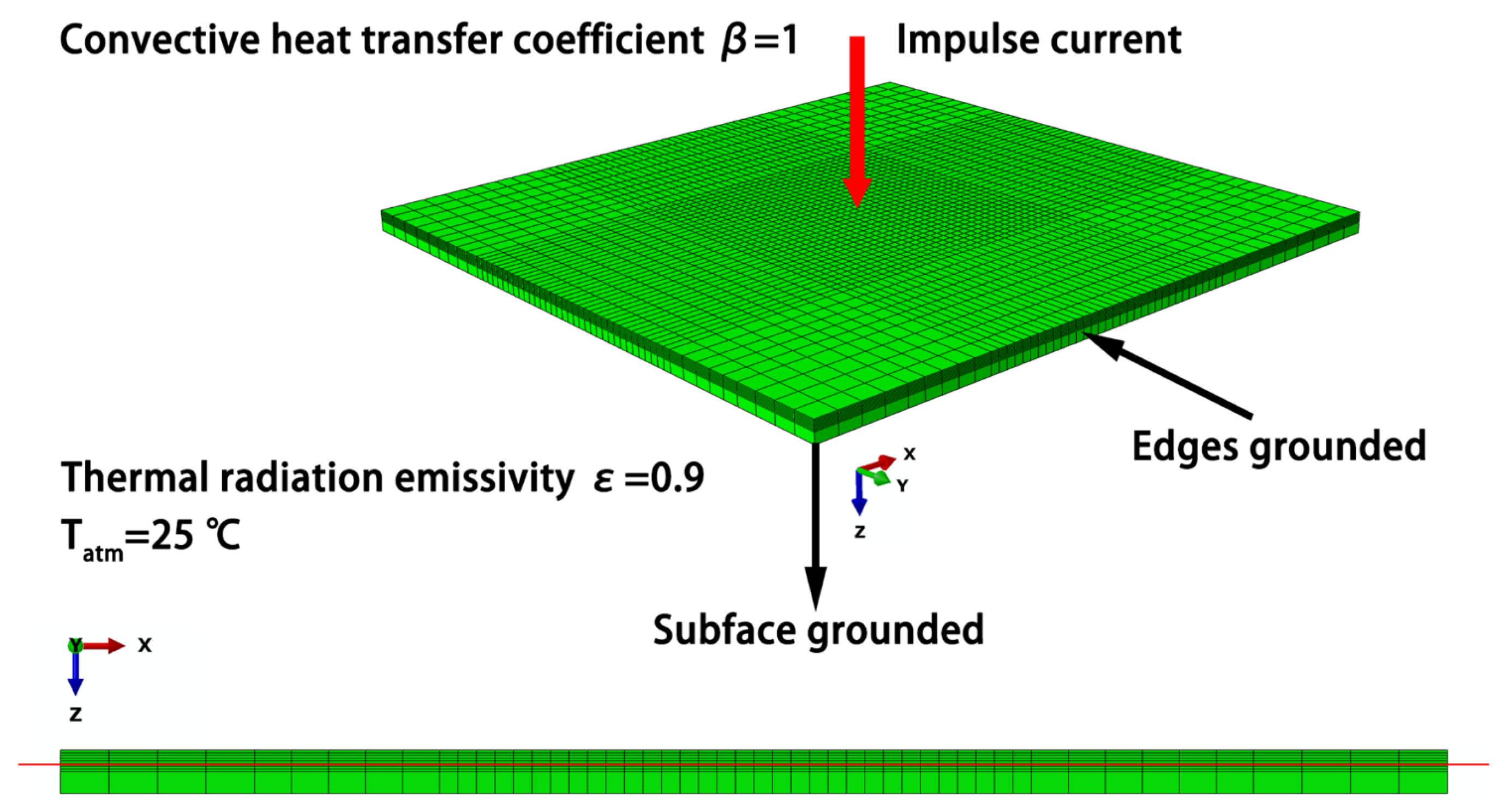

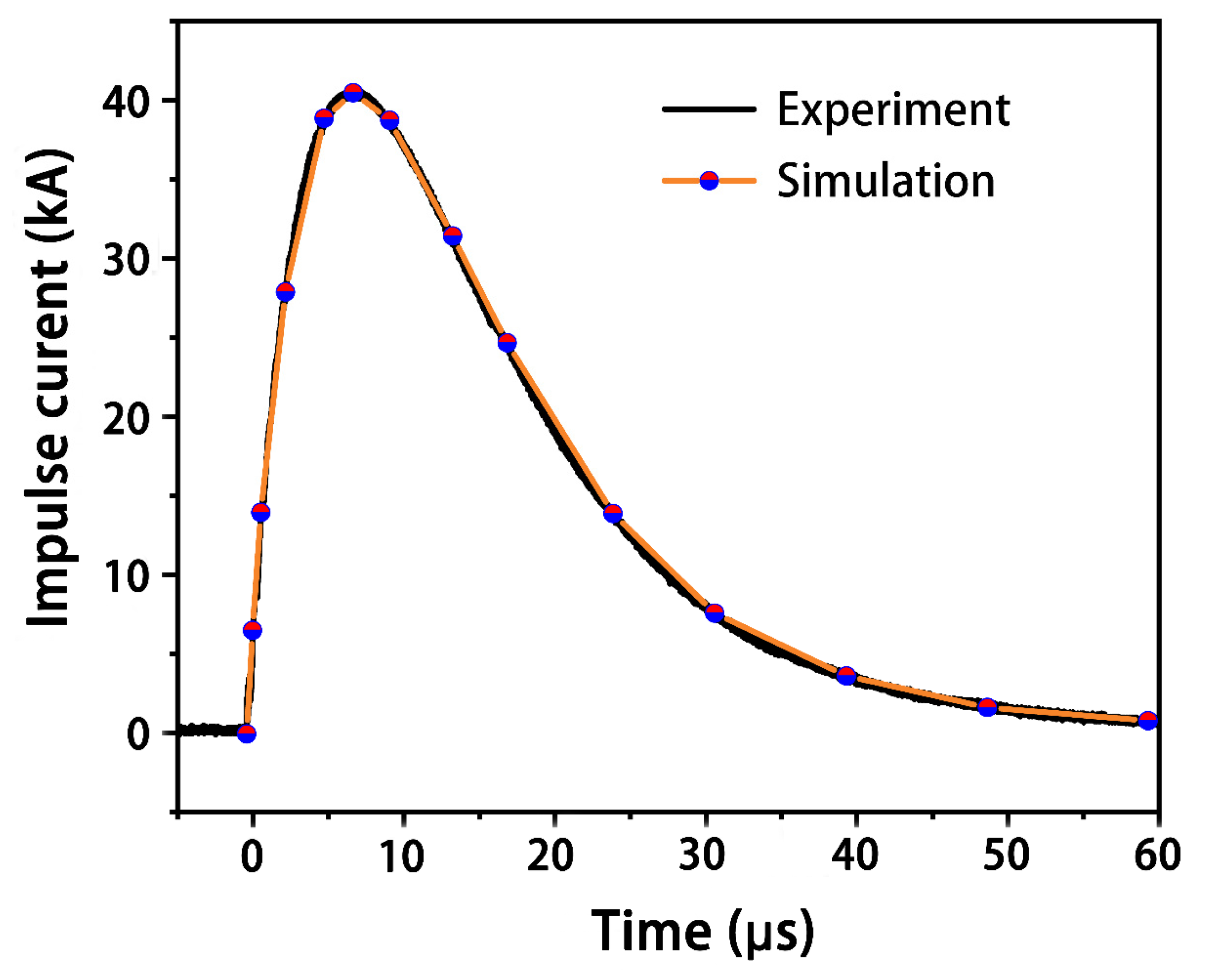


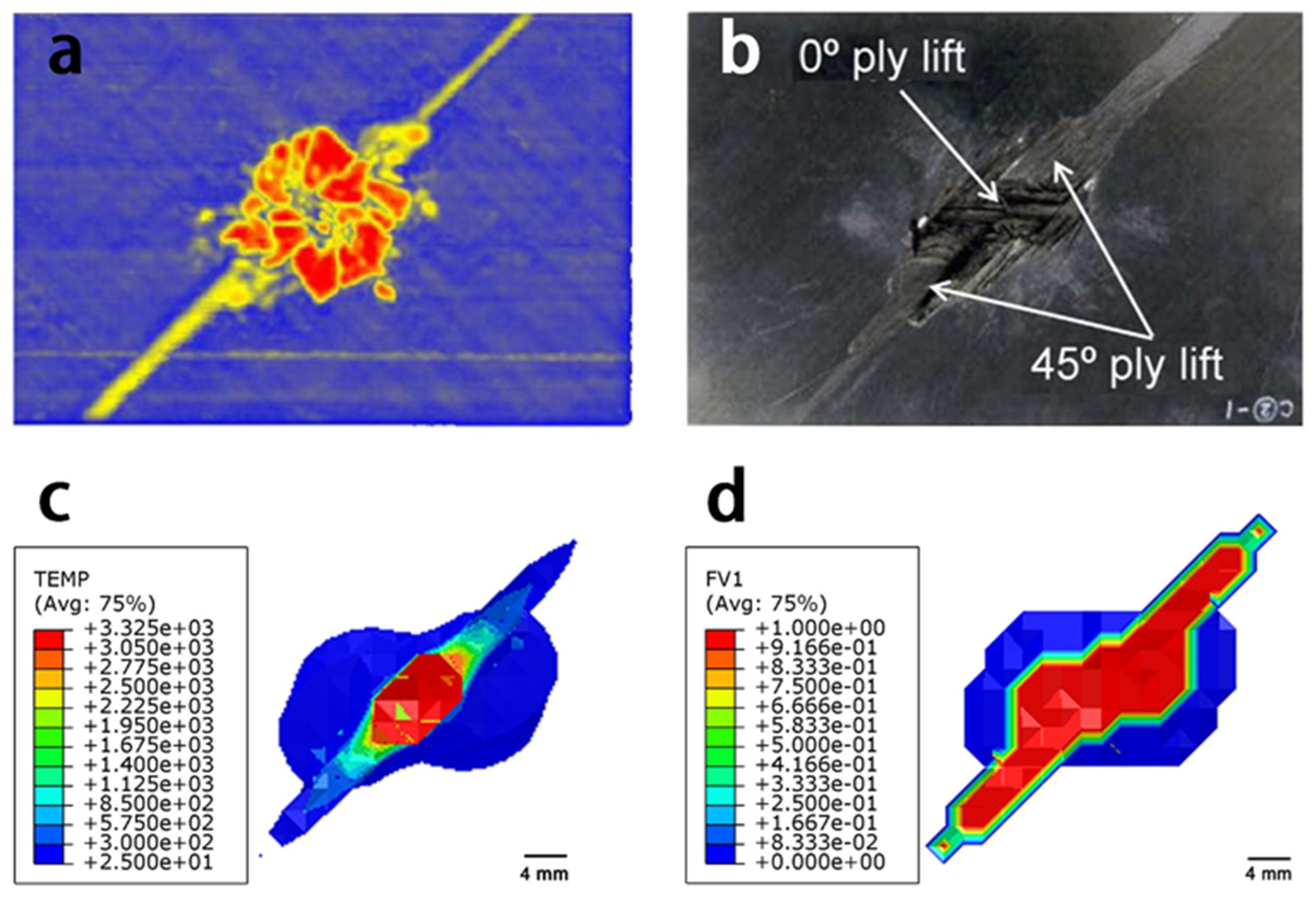


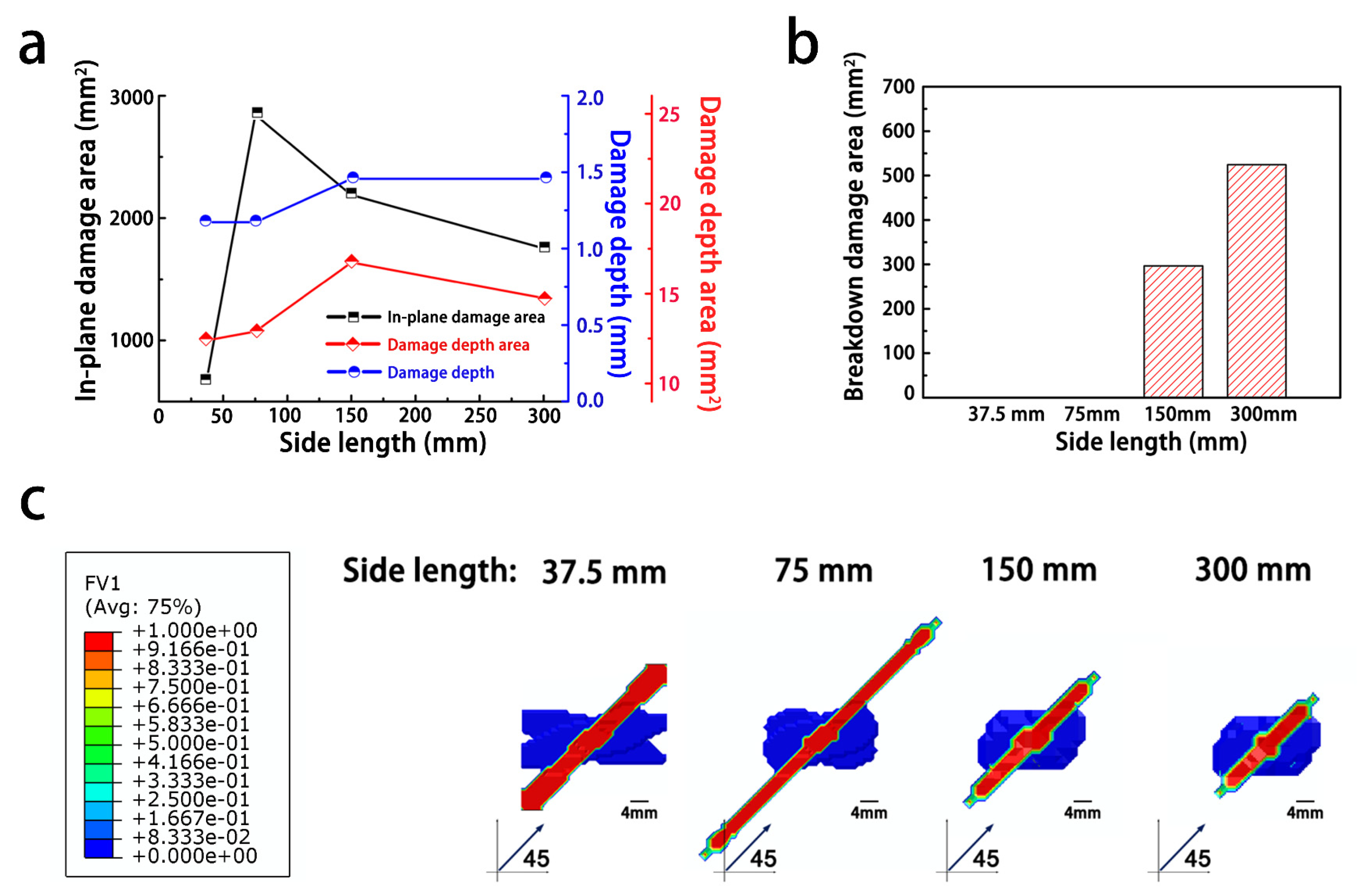
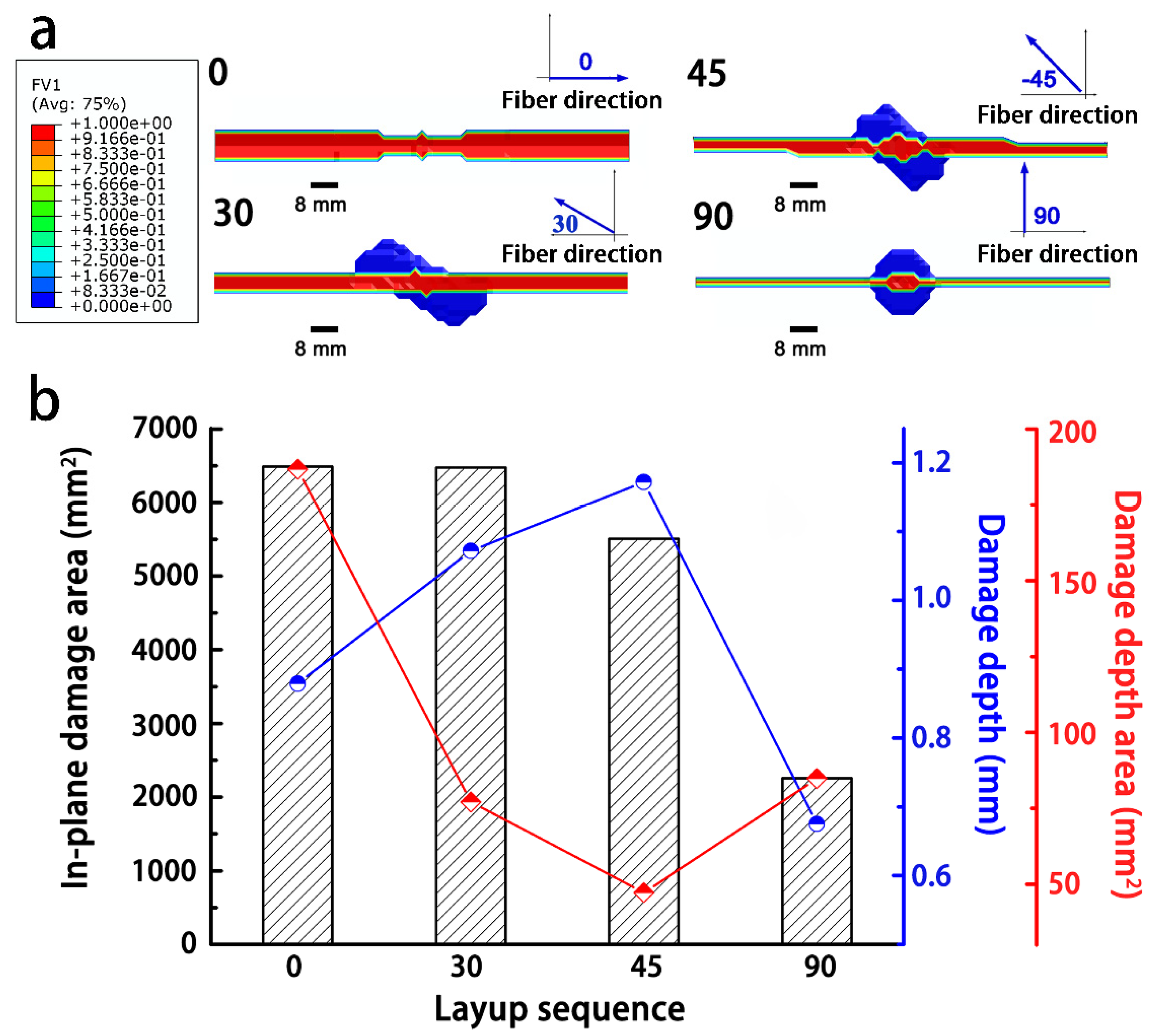
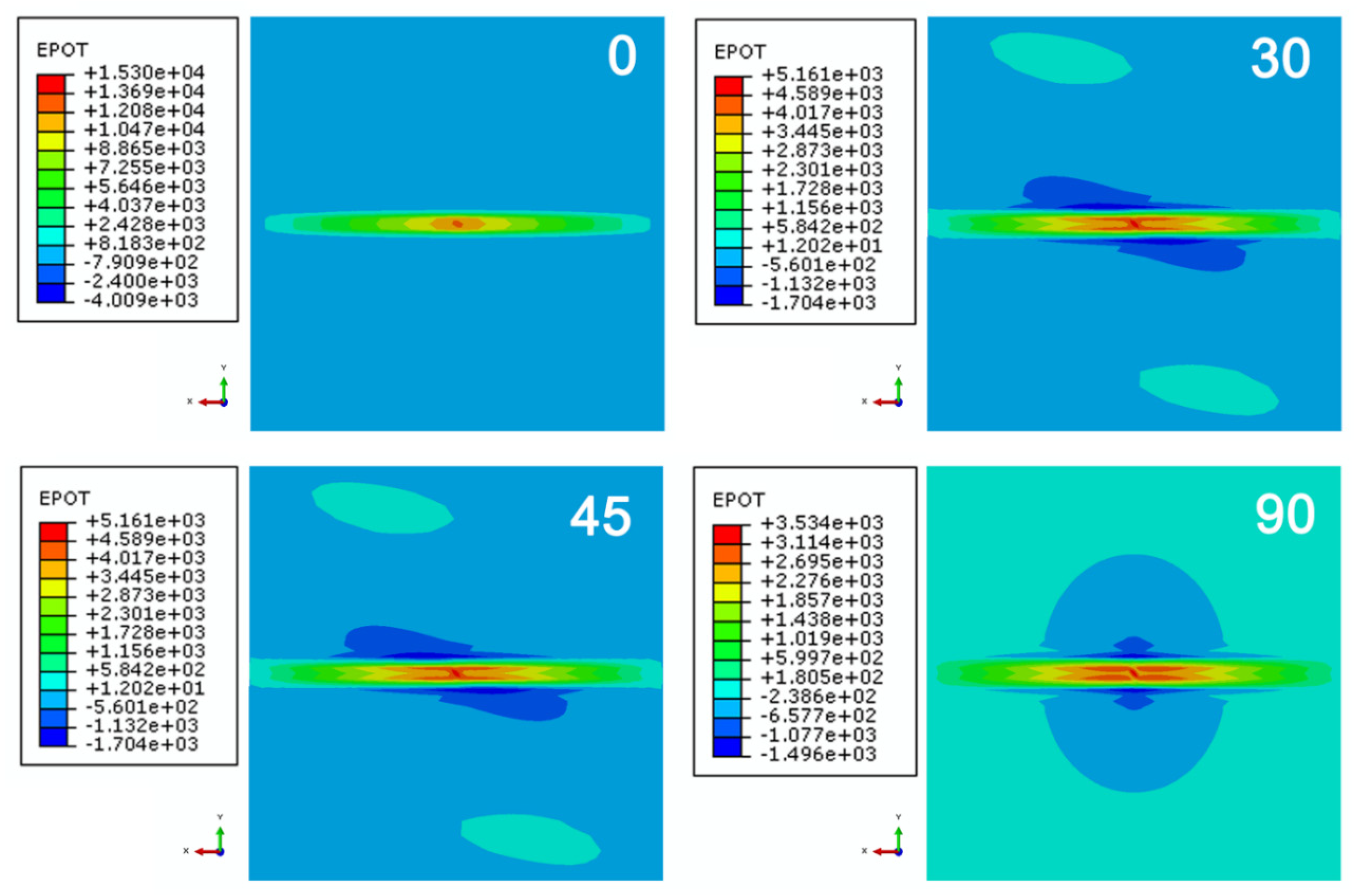
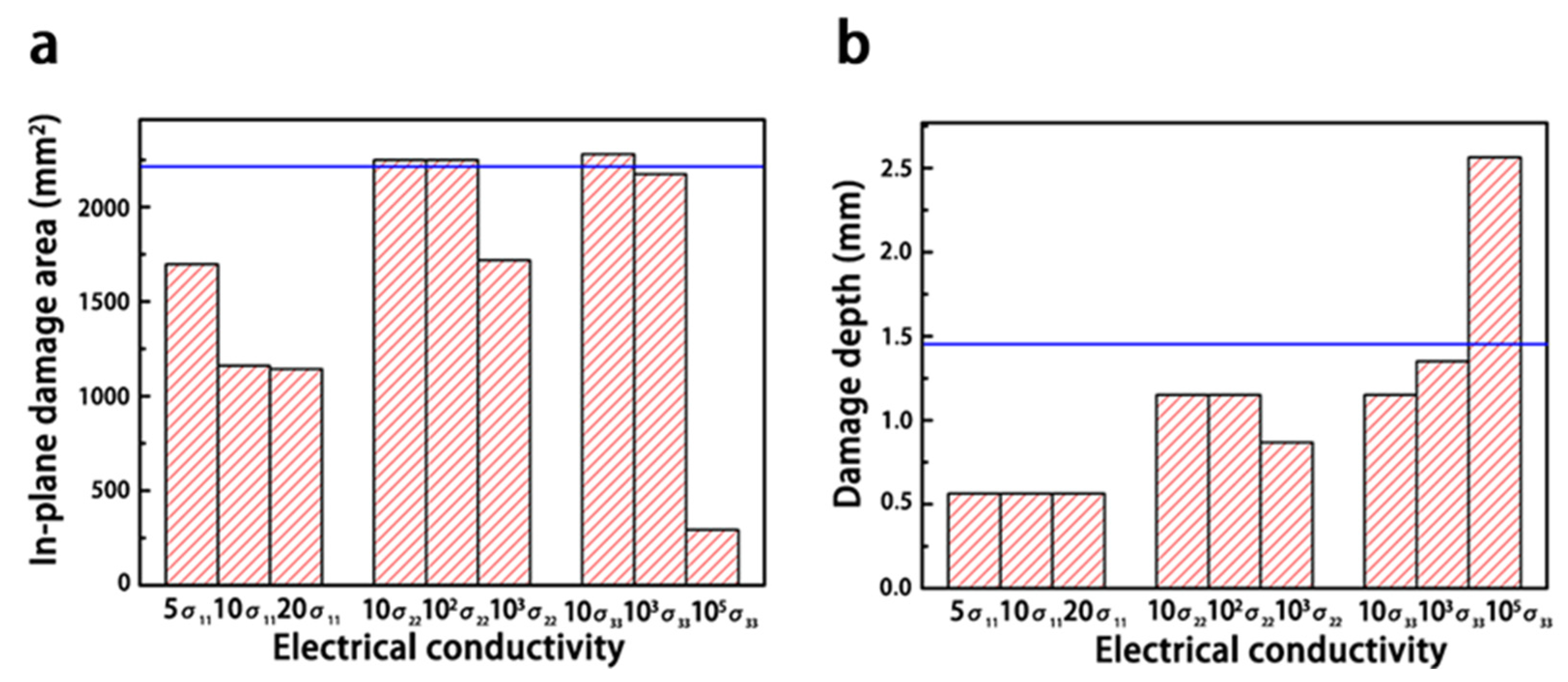
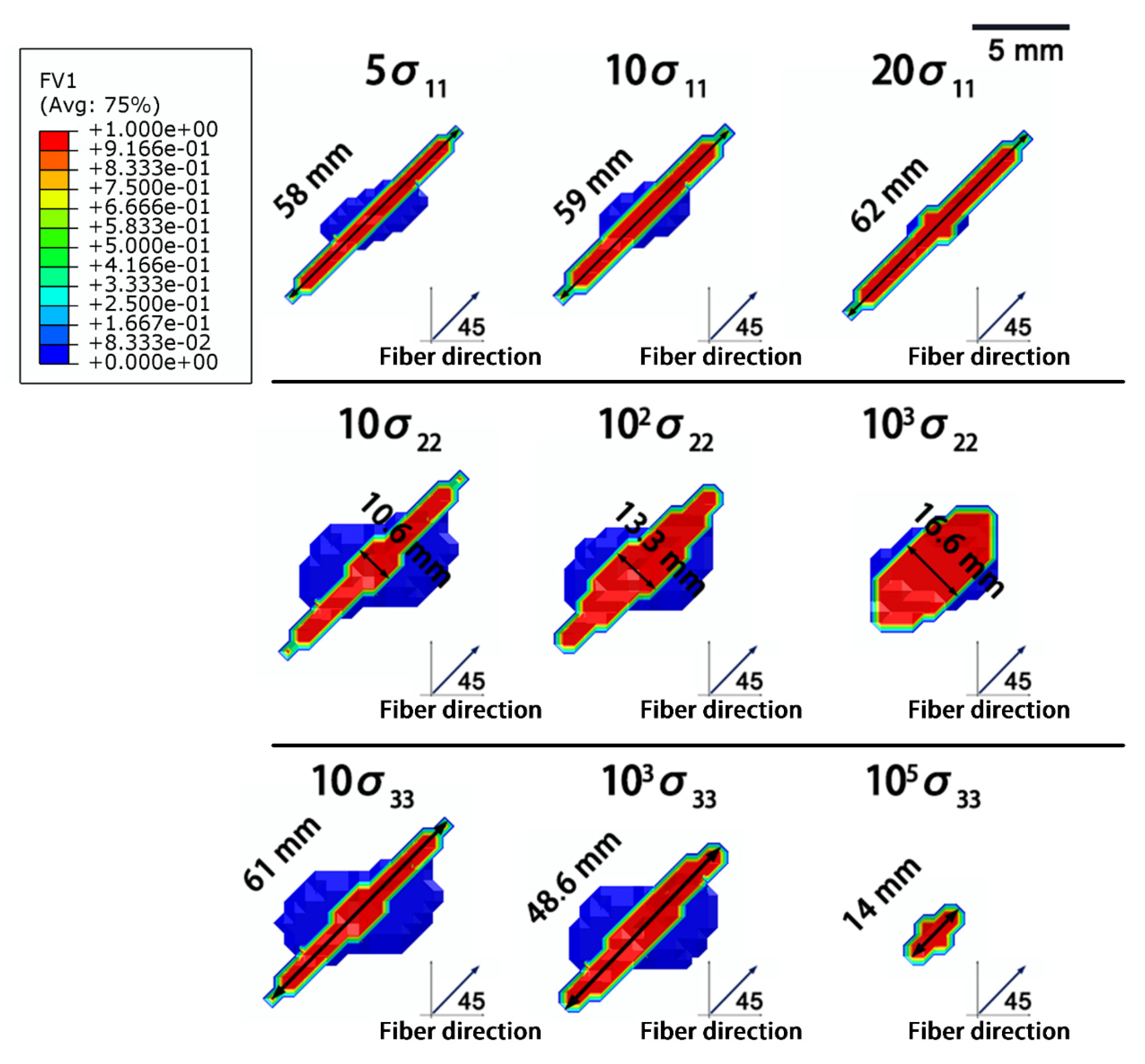

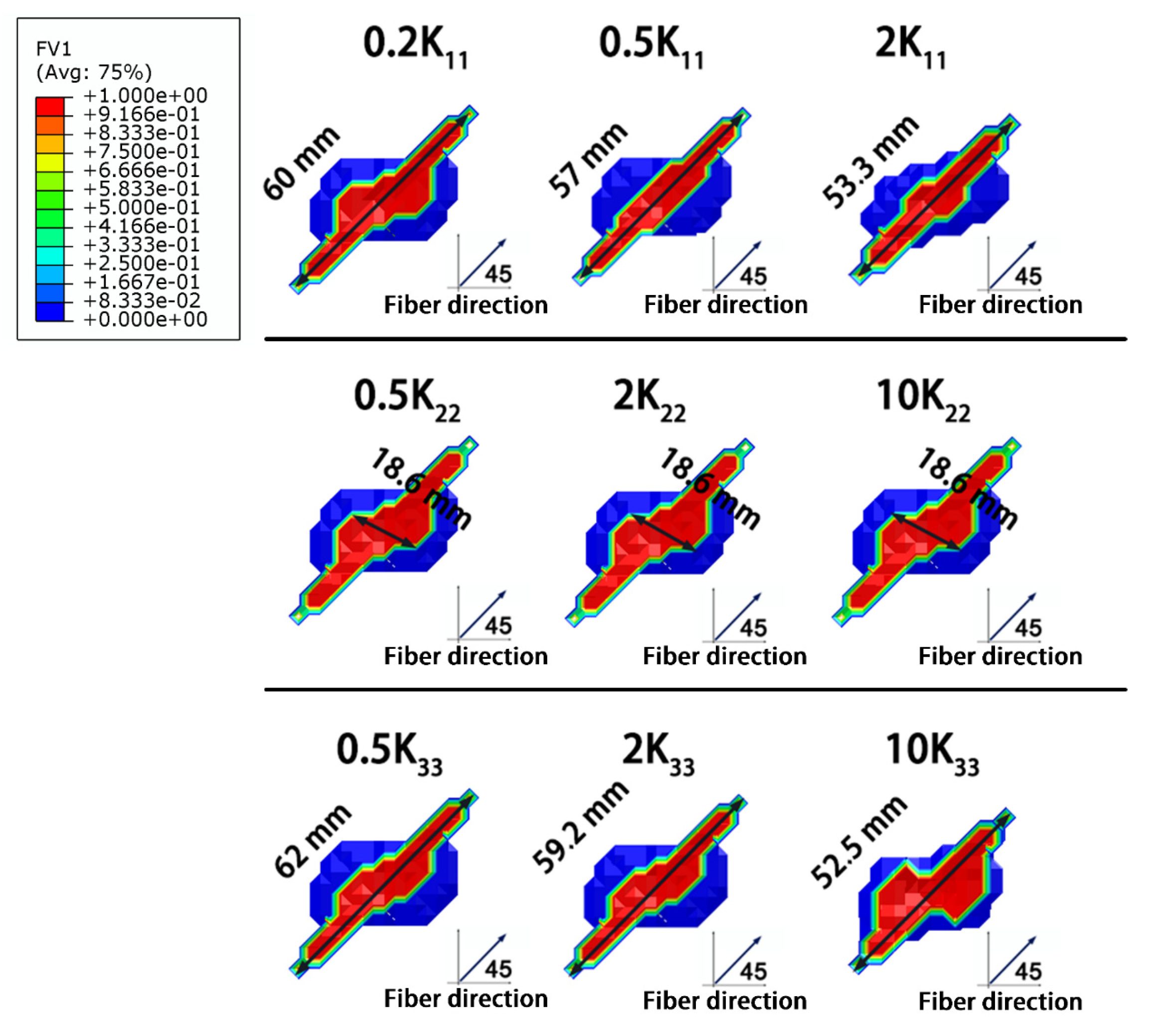
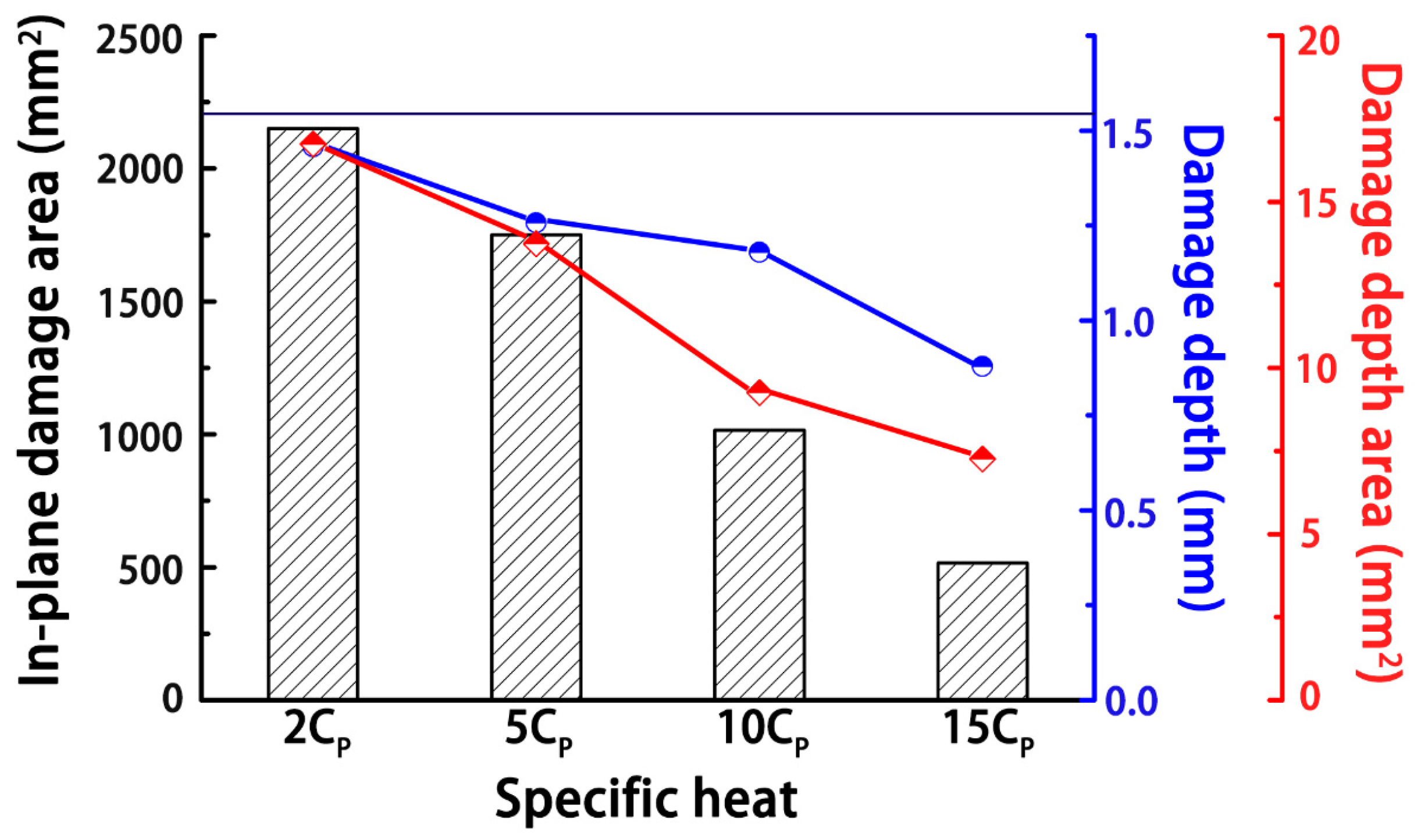
| Temperature (°C) | Cp (J/kg·K) | (1/k) | (1/k) | (1/k) | (W/m·K) | (W/m·K) | (W/m·K) | C |
|---|---|---|---|---|---|---|---|---|
| 25 | 1065 | 1.8 × 10-8 | 2.16 × 10–5 | 2.16 × 10–5 | 11.8 | 0.609 | 0.609 | 0 |
| 600 | 4200 | 5.4 × 10–8 | 3.78 × 10–5 | 3.78 × 10–5 | 1.736 | 0.1 | 0.1 | 1 |
| 1168 | 1800 | 5.4 × 10–8 | 3.78 × 10–5 | 3.78 × 10–5 | 1.736 | 0.1 | 0.1 | 1 |
| 3316 | 2510 | 5.4 × 10–8 | 3.78 × 10–5 | 3.78 × 10–5 | 1.376 | 0.1 | 0.1 | 1 |
| >3316 | 5875 | 5.4 × 10–8 | 3.78 × 10–5 | 3.78 × 10–5 | 0.105 | 0.105 | 1 × 103 | 1 |
| Temperature (°C) | (S/m) | (S/m) | (S/m) | C |
|---|---|---|---|---|
| 25 | 3.6 × 104 | 1.145 | 3.9 × 10−3 | 0 |
| 600 | 3.6 × 104 | 1.145 | 3.9 × 10−3 | 1 |
| 1168 | 3.6 × 104 | 2 × 103 | 2 × 103 | 1 |
| 3316 | 3.6× 104 | 2 × 103 | 2 × 103 | 1 |
| >3316 | 1 × 106 | 2 × 103 | 2 × 103 | 1 |
Publisher’s Note: MDPI stays neutral with regard to jurisdictional claims in published maps and institutional affiliations. |
© 2021 by the authors. Licensee MDPI, Basel, Switzerland. This article is an open access article distributed under the terms and conditions of the Creative Commons Attribution (CC BY) license (https://creativecommons.org/licenses/by/4.0/).
Share and Cite
Zhu, Y.; Ming, Y.; Wang, B.; Duan, Y.; Xiao, H.; Zhang, C.; Sun, J.; Tian, X. Finite Element Analysis of Lightning Damage Factors Based on Carbon Fiber Reinforced Polymer. Materials 2021, 14, 5210. https://doi.org/10.3390/ma14185210
Zhu Y, Ming Y, Wang B, Duan Y, Xiao H, Zhang C, Sun J, Tian X. Finite Element Analysis of Lightning Damage Factors Based on Carbon Fiber Reinforced Polymer. Materials. 2021; 14(18):5210. https://doi.org/10.3390/ma14185210
Chicago/Turabian StyleZhu, Yansong, Yueke Ming, Ben Wang, Yugang Duan, Hong Xiao, Chenping Zhang, Jinru Sun, and Xiangyu Tian. 2021. "Finite Element Analysis of Lightning Damage Factors Based on Carbon Fiber Reinforced Polymer" Materials 14, no. 18: 5210. https://doi.org/10.3390/ma14185210






